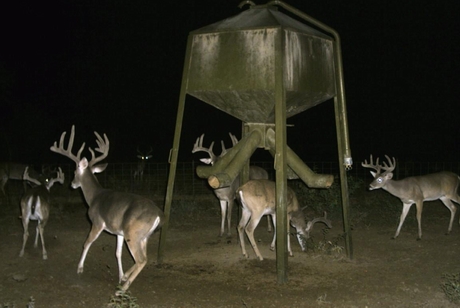Feeding and Disease Transmission
Question: A friend and I are considering starting a supplemental feeding program for the white-tailed deer population on his farm where we hunt. Our goal is to, over time produce larger, healthier bucks and does, as well as attract and holding a larger population of high-quality animals for hunting. I have some concern over supplemental feeding and disease transmission within the deer herd.
We are planning to implement food plots as the main approach to this end, but we are also considering supplemental feeding during the winter, when the does are carrying fawns and the bucks are shedding and preparing for the growth of the coming years antlers.

In my research on supplemental feeds, have I found several articles suggesting that supplemental feeding increases the chances of the transmission of diseases like ‘blue tongue’, which is normally associated with deer using the same watering hole as an infected animal.
I have heard of increased infections and deaths caused by “blue tongue” during droughts, when deer populations are concentrated around fewer waters holes, which increases the probability of coming into contact with infected animals.
I know some of the eastern states have done studies which claim this to be the case for supplemental feeding as well, but has have you heard of supplemental feeding causing such problems? Or has anyone seen the direct problems confirming the results that New Hampshire’s and Maine’s Game and fish claim?
They also mentioned the transmission of the “mad cow-like” disease (chronic wasting disease) is possible between deer fed a supplement is likely. Has anyone heard any thing about this?
Response: Feeding Deer & Spreading Disease
Any time animals are concentrated the chances of disease transmission are increased, regardless of the disease or virus in question. Bluetongue is a non-contagious, insect-borne viral disease of both domestic and wild ruminants, which includes white-tailed deer. Although not contagious, deer will be at an increased risk of infection by carrier insects if they frequent the same areas as infected animals.
Bluetongue virus is endemic to the U.S., but it’s more prevalent in specific areas. As such,if you’ve had a history of blue tongue outbreaks in your area, the chances are good it will happen again. Although cattle and wild ruminants serve as reservoirs for the virus, not all animals will die from the virus.
CWD: Feeding and Disease Transmission
Chronic wasting disease (CWD) is a whole other question. Infectious agents of CWD are neither bacteria nor viruses, but are hypothesized to be prions. Prions are infectious proteins without associated nucleic acids. Research has shown that CWD is very contagious, so deer feeding at a concentrated food source WILL become infected.
However, the location of CWD is fairly well known, so you should know if it is in your area, close to your area, or nowhere around. Contact your state wildlife agency or department of natural resources. In Texas, where I’m located, CWD has not been found despite intensive testing by State wildlife officials.
Research has shown that white-tailed deer, mule deer, and elk will become effected if they come in contact with a CWD infected deer, CWD infected dead deer, or if they enter areas where infected deer or infected deer carcasses have been. Despite the fact that CWD is quite contagious, a few deer still seem to be immune.
One thing to keep in mind: Deer are likely to concentrate somewhere – whether it be a water source, food source, bedding area, or travel corridor. Although providing supplemental food will concentrate deer, I suspect that if a disease or virus is present the pathogen will be passed on regardless of whether or not you provide supplemental feed.
Thanks for the info! Your conclusions, were the same as mine, concerning the congregation of deer and disease transmission. I continued my research after submitting the question to you, and your answers were right in line with other folks concerning Blue-tongue and CWD. The sad thing is, I got my info about blue-tongue from a group of game wardens (“Conservation Officers”) here in Western Kentucky, who must have had method of transmission of blue-tongue mixed up with CWD, as they told me that just the deer drinking from the same water-hole was spreading the disease, but there was no mention of the deer flies and biting gnats that actually spread the disease, to the best of my recollection.
Of course, I could have mis-understood them, but I was pretty sure that they never mentioned the insect element of the transmission of Blue-tongue. Until I happen to be eating at a local restaurant that I regularly eat lunch at, and over heard their conversation concerning the effects of a mid-summer drought on the wildlife management area, I had never heard of blue-tongue.
And until I started researching communicable diseases and deer management, I had never heard of CWD. I wonder if a way to innoculate the deer against blue-tongue could be developed… may introduced through supplemental feeding. Anyway, if deer are like most animals, and I think they are, then the supplemental feeding and especially the food plots with better food value forage should make them healthier and better able to fight off an infection of any kind, as well as producing larger racks and all around healthier does and fawns.
Anyway, thanks again for the thoughtful and insightful answer to my questions!
Sincerely,
Mark
If the feed you use contains meat products from rendering plants that is suspected of causing many of the livestock diseases we are seeing now.
References:
Could Mad Cow Disease Already be Killing Thousands of Americans …
Jan 7, 2004 – [23] Maybe some cases of sporadic CJD in the U.S. are caused by sheep meat as well.
Mad Cow Disease In Dogs…Animal Wellness Magazine
https://animalwellnessmagazine.com/mad-cow-disease/
Mad Cow disease has reared it’s ugly head in North America.